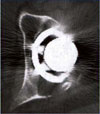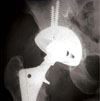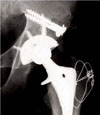Abstract
Recently, the incidence of revision total hip arthroplasty following primary total hip arthroplasty has increased. However, revision after primary total hip arthroplasty is usually much more difficult than the first time, and the results are typically not as satisfactory as that after most primary total hip arthroplasty procedures. Therefore, thoughtful and thorough preoperative planning will certainly provides the patient with the best opportunity for long-term success.
In particular, location and size of acetabular bone defects dictate the type of acetabular component in revision in total hip arthroplasty. For most defects, a porous-coated hemispherical shell secured to host bone with multiple screws is the implant of choice. This reconstruction is feasible provided that at least 50% of the implant is in contact with host bone. When such contact is not possible, and there is adequate medial and peripheral bone, techniques using alternative uncemented implants can be used for acetabular reconstruction. Defects with greater bone loss or compromised columns require the use of either modular augments combined with a hemispherical shell, reconstruction cages, structural allografts, or impaction allograft.
Therefore, we attempt to introduce the most commonly-adopted system for classification of acetabular defects and the necessary preoperative evaluation, intraoperative detail, and reported results of these acetabular revisions.
Figures and Tables
 | Fig. 3(A) Trabecular metal modular augments and (B) uncemented acetabular cup. These cups and augments are manufactured in multiple sizes and shapes to accommodate various bony defects. |
 | Fig. 4Intraoperative photograph showing a well-fixed cup. The lesion was debrided through the screw hole in the cup with curettes. |
References
1. Issack PS, Nousiainen M, Beksac B, Helfet DL, Sculco TP, Buly RL. Acetabular component revision in totoal hip arthroplasty. Part I: cementless shells. Am J Orthop (Belle Mead NJ). 2009; 38:509–514.
2. Issack PS, Nousiainen M, Beksac B, Helfet DL, Sculco TP, Buly RL. Acetabular component revision in total hip arthroplasty. Part II: management of major bone loss and pelvic discontinuity. Am J Orthop (Belle Mead NJ). 2009; 38:550–556.
3. Pulido L, Rachala SR, Cabanela ME. Cementless acetabular revision: past, present, and future. Revision total hip arthroplasty: the acetabular side using cementless implants. Int Orthop. 2011; 35:289–298.
4. Blumenfeld TJ. Implant choices, technique, and results in revision acetabular surgery: a review. Hip Int. 2012; 22:235–247.

5. Jiranek WA. Acetabular liner fixation by cement. Clin Orthop Relat Res. 2003; (417):217–223.
6. Jasty M. Jumbo cups and morsalized graft. Orthop Clin North Am. 1998; 29:249–254.
7. Lachiewicz PF, Poon ED. Revision of a total hip arthroplasty with a Harris-Galante porous-coated acetabular component inserted without cement. A follow-up note on the results at five to twelve years. J Bone Joint Surg Am. 1998; 80:980–984.

8. Leopold SS, Jacobs JJ, Rosenberg AG. Cancellous allograft in revision total hip arthroplasty. A clinical review. Clin Orthop Relat Res. 2000; (371):86–97.
9. Zimlich RH, Fehring TK. Underestimation of pelvic osteolysis: the value of the iliac oblique radiograph. J Arthroplasty. 2000; 15:796–801.
10. Claus AM, Totterman SM, Sychterz CJ, Tamez-Peña JG, Looney RJ, Engh CA Sr. Computed tomography to assess pelvic lysis after total hip replacement. Clin Orthop Relat Res. 2004; (422):167–174.

11. D'Antonio JA, Capello WN, Borden LS, et al. Classification and management of acetabular abnormalities in total hip arthroplasty. Clin Orthop Relat Res. 1989; (243):126–137.
12. Paprosky WG, Perona PG, Lawrence JM. Acetabular defect classification and surgical reconstruction in revision arthroplasty. A 6-year follow-up evaluation. J Arthroplasty. 1994; 9:33–44.

13. Koh KH, Moon YW, Lim SJ, Lee HI, Shim JW, Park YS. Complete acetabular cup revision versus isolated liner exchange for polyethylene wear and osteolysis without loosening in cementless total hip arthroplasty. Arch Orthop Trauma Surg. 2011; 131:1591–1600.

14. Archibeck MJ, Junick DW, Cummins T, Carothers J, White RE Jr. Polyethylene exchange in a second-generation cementless acetabular component. J Arthroplasty. 2009; 24:69–72.

15. Restrepo C, Ghanem E, Houssock C, Austin M, Parvizi J, Hozack WJ. Isolated polyethylene exchange versus acetabular revision for polyethylene wear. Clin Orthop Relat Res. 2009; 467:194–198.

16. Lie SA, Hallan G, Furnes O, Havelin LI, Engesaeter LB. Isolated acetabular liner exchange compared with complete acetabular component revision in revision of primary uncemented acetabular components: a study of 1649 revisions from the Norwegian Arthroplasty Register. J Bone Joint Surg Br. 2007; 89:591–594.
17. Smith TM, Berend KR, Lombardi AV Jr, Mallory TH, Russell JH. Isolated liner exchange using the anterolateral approach is associated with a low risk of dislocation. Clin Orthop Relat Res. 2005; 441:221–226.

18. LaPorte DM, Mont MA, Pierre-Jacques H, Peyton RS, Hungerford DS. Technique for acetabular liner revision in a nonmodular metal-backed component. J Arthroplasty. 1998; 13:348–350.

19. Hozack WJ, Parvizi J, Bender B. Surgical treatment of hip arthritis: reconstruction, replacement, and revision. 1th ed. Philadelphia: Saunders/Elsevier;2009. p. 336–343.
20. Kwon SY, Song JH, Han SK, Kim DY, Kim SM, Lee KH. Short term results of cementation of a polyethylene liner into a well-fixed metal shell. J Korean Hip Soc. 2009; 21:320–326.

21. Dearborn JT, Harris WH. High placement of an acetabular component inserted without cement in a revision total hip arthroplasty. Results after a mean of ten years. J Bone Joint Surg Am. 1999; 81:469–480.

22. Doehring TC, Rubash HE, Shelley FJ, Schwendeman LJ, Donaldson TK, Navalgund YA. Effect of superior and superolateral relocations of the hip center on hip joint forces. An experimental and analytical analysis. J Arthroplasty. 1996; 11:693–703.

23. Murayama T, Ohnishi H, Okabe S, et al. 15-year comparison of cementless total hip arthroplasty with anatomical or high cup placement for Crowe I to III hip dysplasia. Orthopedics. 2012; 35:e313–e318.

24. Hendricks KJ, Harris WH. High placement of noncemented acetabular components in revision total hip arthroplasty. A concise follow-up, at a minimum of fifteen years, of a previous report. J Bone Joint Surg Am. 2006; 88:2231–2236.

25. Gustke KA. Jumbo cup or high hip center: is bigger better? J Arthroplasty. 2004; 19:120–123.
26. Ito H, Matsuno T, Aoki Y, Minami A. Acetabular components without bulk bone graft in revision surgery: A 5- to 13-year follow-up study. J Arthroplasty. 2003; 18:134–139.
27. Whaley AL, Berry DJ, Harmsen WS. Extra-large uncemented hemispherical acetabular components for revision total hip arthroplasty. J Bone Joint Surg Am. 2001; 83-A:1352–1357.

28. Yoo MC. Revision total hip arthroplasty using acetabular reinforcement ring. J Korean Hip Soc. 2004; 16:183–190.
29. Berry DJ, Müller ME. Revision arthroplasty using an antiprotrusio cage for massive acetabular bone deficiency. J Bone Joint Surg Br. 1992; 74:711–715.

30. Zehntner MK, Ganz R. Midterm results (5.5-10 years) of acetabular allograft reconstruction with the acetabular reinforcement ring during total hip revision. J Arthroplasty. 1994; 9:469–479.

31. Schreurs BW, Slooff TJ, Buma P, Gardeniers JW, Huiskes R. Acetabular reconstruction with impacted morsellised cancellous bone graft and cement. A 10- to 15-year follow-up of 60 revision arthroplasties. J Bone Joint Surg Br. 1998; 80:391–395.
32. Knight JL, Fujii K, Atwater R, Grothaus L. Bone-grafting for acetabular deficiency during primary and revision total hip arthroplasty. A radiographic and clinical analysis. J Arthroplasty. 1993; 8:371–382.

33. Patel JV, Masonis JL, Bourne RB, Rorabeck CH. The fate of cementless jumbo cups in revision hip arthroplasty. J Arthroplasty. 2003; 18:129–133.

34. Sun C, Lian YY, Jin YH, Zhao CB, Pan SQ, Liu XF. Clinical and radiographic assessment of cementless acetabular revision with morsellised allografts. Int Orthop. 2009; 33:1525–1530.

35. Etienne G, Bezwada HP, Hungerford DS, Mont MA. The incorporation of morselized bone grafts in cementless acetabular revisions. Clin Orthop Relat Res. 2004; (428):241–246.

36. Woolson ST, Adamson GJ. Acetabular revision using a bone-ingrowth total hip component in patients who have acetabular bone stock deficiency. J Arthroplasty. 1996; 11:661–667.

37. Dorr LD, Wan Z. Ten years of experience with porous acetabular components for revision surgery. Clin Orthop Relat Res. 1995; (319):191–200.

38. Sporer SM, O'Rourke M, Chong P, Paprosky WG. The use of structural distal femoral allografts for acetabular reconstruction. Average ten-year follow-up. J Bone Joint Surg Am. 2005; 87:760–765.

39. Piriou P, Sagnet F, Norton MR, de Loubresse CG, Judet T. Acetabular component revision with frozen massive structural pelvic allograft: average 5-year follow-up. J Arthroplasty. 2003; 18:562–569.

40. Kwong LM, Jasty M, Harris WH. High failure rate of bulk femoral head allografts in total hip acetabular reconstructions at 10 years. J Arthroplasty. 1993; 8:341–346.

41. Schelfaut S, Cool S, Mulier M. The use of structural periacetabular allografts in acetabular revision surgery: 2.5-5 years follow-up. Arch Orthop Trauma Surg. 2009; 129:455–461.

42. Hooten JP Jr, Engh CA Jr, Engh CA. Failure of structural acetabular allografts in cementless revision hip arthroplasty. J Bone Joint Surg Br. 1994; 76:419–422.

43. Paprosky WG, Magnus RE. Principles of bone grafting in revision total hip arthroplasty. Acetabular technique. Clin Orthop Relat Res. 1994; (298):147–155.
44. Pollock FH, Whiteside LA. The fate of massive allografts in total hip acetabular revision surgery. J Arthroplasty. 1992; 7:271–276.





 PDF
PDF ePub
ePub Citation
Citation Print
Print















 XML Download
XML Download